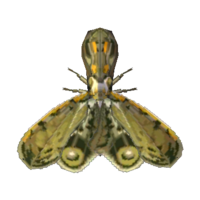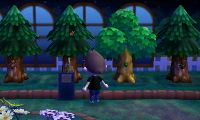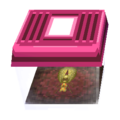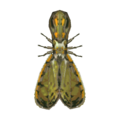Difference between revisions of "Lantern fly"
Cephalobot (talk | contribs) m (Text replacement - "\|( *)?rarity(.*?)\n\|( *)?price(.*?)\n}}" to "}}") |
AlexBot2004 (talk | contribs) m |
||
| (12 intermediate revisions by 7 users not shown) | |||
| Line 1: | Line 1: | ||
{{Infobox Bug | {{Infobox Bug | ||
| − | |name = | + | |name = lantern fly |
|ja-name = ビワハゴロモキ | |ja-name = ビワハゴロモキ | ||
|ko-name = 뿔매미 | |ko-name = 뿔매미 | ||
| Line 10: | Line 10: | ||
|nl-name = Lantaarndrager | |nl-name = Lantaarndrager | ||
|ru-name = Фонарница | |ru-name = Фонарница | ||
| − | |image = Lantern Fly NL.png | + | |image = Lantern Fly NL Model.png |
| + | |icon = Lantern Fly NL Icon.png | ||
|scientific name = {{wp|Fulgora laternaria}} | |scientific name = {{wp|Fulgora laternaria}} | ||
|family = {{wp|Fulgoridae}} - Lantern Flies | |family = {{wp|Fulgoridae}} - Lantern Flies | ||
}} | }} | ||
| − | The ''' | + | The '''lantern fly'''{{Note|{{Nihongo foot|ビワハゴロモ|Biwahagoromo}}}} is a [[bug]] in the {{SER}} introduced in {{WW}}. It is found on [[trees]] between [[June (month)|June]] and [[September]] at two different times of the evening, between 4 PM and 7 PM then again from 11 PM to 8 AM. It is uncommon and can be found in the rain as well as on clear evenings. |
==Catch details== | ==Catch details== | ||
| Line 23: | Line 24: | ||
|catchphrase= I caught a lantern fly! You light up my life! | |catchphrase= I caught a lantern fly! You light up my life! | ||
|description= Their heads look exactly like an alligator's. They look like moths, but are actually cicadas. | |description= Their heads look exactly like an alligator's. They look like moths, but are actually cicadas. | ||
| − | | | + | |availability= Jun – Sep |
| − | | | + | |times= 4 PM – 7 PM; 11 PM – 8 AM |
| + | |m6=Yes | ||
| + | |m7=Yes | ||
| + | |m8-1=Yes | ||
| + | |m8-2=Yes | ||
| + | |m9-1=Yes | ||
| + | |m9-2=Yes | ||
|location= On trees | |location= On trees | ||
|rarity= | |rarity= | ||
| Line 44: | Line 51: | ||
|time2= 4 PM – 8 AM | |time2= 4 PM – 8 AM | ||
|time2-availability= Jul – Aug | |time2-availability= Jul – Aug | ||
| − | |m6 = Yes | + | | m6 = Yes |
| − | |m7 = Yes | + | | m7 = Yes |
| − | |m8-1 = Yes | + | | m8-1 = Yes |
| − | |m8-2 = Yes | + | | m8-2 = Yes |
| − | |m9-1 = Yes | + | | m9-1 = Yes |
| − | |m9-2 = Yes | + | | m9-2 = Yes |
|m7_time = 4 PM – 8 AM | |m7_time = 4 PM – 8 AM | ||
|m8-1_time = 4 PM – 8 AM | |m8-1_time = 4 PM – 8 AM | ||
|m8-2_time = 4 PM – 8 AM | |m8-2_time = 4 PM – 8 AM | ||
|location=On trees (hardwood and cedar) | |location=On trees (hardwood and cedar) | ||
| + | | bug-size = 70 mm | ||
|rarity= Rare | |rarity= Rare | ||
|sell= 1800 | |sell= 1800 | ||
| Line 59: | Line 67: | ||
|tank-length= 1.0 | |tank-length= 1.0 | ||
}} | }} | ||
| − | |||
===In {{NL|short|nolink}}=== | ===In {{NL|short|nolink}}=== | ||
| Line 66: | Line 73: | ||
| image= Lantern Fly NL Icon.png | | image= Lantern Fly NL Icon.png | ||
| catchphrase= I caught a lantern fly! Hmm. Must have run out of gas. | | catchphrase= I caught a lantern fly! Hmm. Must have run out of gas. | ||
| − | | availability = Jun | + | | availability = Jun – Sep |
| times= 4 PM – 7 PM & 11 PM – 8 AM | | times= 4 PM – 7 PM & 11 PM – 8 AM | ||
| time-availability = Jun; Sep | | time-availability = Jun; Sep | ||
| Line 73: | Line 80: | ||
|tortimer-island-time = 4 PM – 8 AM | |tortimer-island-time = 4 PM – 8 AM | ||
| location= On trees (hardwood and cedar) | | location= On trees (hardwood and cedar) | ||
| − | |m6 = Yes | + | | m6 = Yes |
| − | |m7 = Yes | + | | m7 = Yes |
| − | |m8-1 = Yes | + | | m8-1 = Yes |
| − | |m8-2 = Yes | + | | m8-2 = Yes |
| − | |m9-1 = Yes | + | | m9-1 = Yes |
| − | |m9-2 = Yes | + | | m9-2 = Yes |
|m7_time = 4 PM – 8 AM | |m7_time = 4 PM – 8 AM | ||
|m8-1_time = 4 PM – 8 AM | |m8-1_time = 4 PM – 8 AM | ||
| Line 90: | Line 97: | ||
==Donating to the museum== | ==Donating to the museum== | ||
| − | As with all insects in the {{SER}}, the | + | As with all insects in the {{SER}}, the lantern lly can be donated to the [[museum]] by talking to [[Blathers]], who will give a small talk about it. |
===In {{WW|short|nolink}}=== | ===In {{WW|short|nolink}}=== | ||
| Line 98: | Line 105: | ||
{{Blathers|CF|It's said that a diet of sap from the lychee tree makes the bodily fluids of the lantern fly sweet. It's also said the proper way to try them is to break off the tips of the horns and sip them like straws... It's ALSO said that anyone who does those things is officially googly-boogly out of his or her mind.}} | {{Blathers|CF|It's said that a diet of sap from the lychee tree makes the bodily fluids of the lantern fly sweet. It's also said the proper way to try them is to break off the tips of the horns and sip them like straws... It's ALSO said that anyone who does those things is officially googly-boogly out of his or her mind.}} | ||
| − | The | + | The lantern fly can be found in the top-most level of the insect section of the museum, perched on the right-most cedar tree, next to the sign. |
===In {{NL|short|nolink}}=== | ===In {{NL|short|nolink}}=== | ||
[[File:NL Tree Bugs 1.jpg|200px|thumb|right|The Lantern Fly resting on a tree in the museum in {{NL}}]] | [[File:NL Tree Bugs 1.jpg|200px|thumb|right|The Lantern Fly resting on a tree in the museum in {{NL}}]] | ||
| − | Upon being donated, the | + | Upon being donated, the lantern fly can be found in the room of the bug exhibit with the light in, resting on a tree near the light. The exhibit has this to say about the lantern fly: |
{{Blathers|NL|Lantern flies stay on trees to drink tree sap, which is where you'll most commonly find them. Their heads are shaped like alligators, though this is just an odd coincidence. Their wings have patterns that look like eyes so when they're open they can scare off predators. They don't really cry that much, but they are still related to cicadas to some extent.}} | {{Blathers|NL|Lantern flies stay on trees to drink tree sap, which is where you'll most commonly find them. Their heads are shaped like alligators, though this is just an odd coincidence. Their wings have patterns that look like eyes so when they're open they can scare off predators. They don't really cry that much, but they are still related to cicadas to some extent.}} | ||
| Line 109: | Line 116: | ||
==Real-world information== | ==Real-world information== | ||
| − | ''Fulgora laternaria'' (also known as | + | ''Fulgora laternaria'' (also known as the lantern fly, alligator bug, peanut bug, etc.) is related to cicadas. It gets the name 'alligator bug' from its oddly shaped and colored head. Its head is shaped like a serpent or lizard, similar to an alligator's head, which is mentioned in the description in the ''Bugs and Fish'' tab. The name 'lantern fly' however, comes from the mistaken belief, first by {{wp|Carl Linnaeus}}, that they are luminescent. It protects itself by opening its wings, which reveals {{wp|Eyespot (mimicry)|fake eyes}}. Its head may also further protect itself, by scaring potential predators. In the {{SER|nolink}}, it displays its wings when the [[player]] gets close to it. |
{{Clear}} | {{Clear}} | ||
| Line 125: | Line 132: | ||
{{Note list}} | {{Note list}} | ||
| − | {{Bugs}} | + | {{Navbox Bugs}} |
[[Category:Wild World bugs]] | [[Category:Wild World bugs]] | ||
[[Category:City Folk bugs]] | [[Category:City Folk bugs]] | ||
[[Category:New Leaf bugs]] | [[Category:New Leaf bugs]] | ||
| + | [[Category:Happy Home Designer bugs]] | ||
[[Category:Removed bugs]] | [[Category:Removed bugs]] | ||
| + | |||
| + | [[es:Machaca]] | ||
Latest revision as of 23:58, May 7, 2024
| ||||||||
 | ||||||||
| Real-world info | ||||||||
|---|---|---|---|---|---|---|---|---|
| Name: Fulgora laternaria Family: Fulgoridae - Lantern Flies | ||||||||
| Main appearances | ||||||||
|
| ||||||||
| Other appearances | ||||||||
Names in other languages
ビワハゴロモキ
N/A laternaria machaca lanternaria Фонарница
뿔매미 N/A laternaria machaca Laternenträger Lantaarndrager | ||||||||
The lantern fly[nb 1] is a bug in the Animal Crossing series introduced in Animal Crossing: Wild World. It is found on trees between June and September at two different times of the evening, between 4 PM and 7 PM then again from 11 PM to 8 AM. It is uncommon and can be found in the rain as well as on clear evenings.
Catch details[edit]
In Wild World[edit]
| Description | Their heads look exactly like an alligator's. They look like moths, but are actually cicadas. |
|---|---|
| Time of year | Jun – Sep |
| Time of day | 4 PM – 7 PM; 11 PM – 8 AM |
| Peak times | N/A |
| Location | On trees |
| Bug size | Unknown |
| Selling price | |
| Furniture size |
In City Folk[edit]
| Description | With alligator-like heads and mothlike wings, these are actually cicadas. |
|---|---|
| Time of year | Jun – Sep |
| Time of day | Jun; Sep: 4 PM – 7 PM & 11 PM – 8 AM Jul – Aug: 4 PM – 8 AM |
| Peak times | N/A |
| Location | On trees (hardwood and cedar) |
| Bug size | 70 mm |
| Rarity | Rare |
| Selling price | |
| Furniture size |
In New Leaf[edit]
| Time of year | Jun – Sep All year (Tortimer Island) |
|---|---|
| Time of day | Jun; Sep: 4 PM – 7 PM & 11 PM – 8 AM Jul – Aug: 4 PM – 8 AM Tortimer Island: 4 PM – 8 AM |
| Peak times | N/A |
| Location | On trees (hardwood and cedar) (can be found on Tortimer Island) |
| Size | Unknown |
| Rarity | Rare |
| Selling price | |
| Furniture size |
Donating to the museum[edit]
As with all insects in the Animal Crossing series, the lantern lly can be donated to the museum by talking to Blathers, who will give a small talk about it.
In Wild World[edit]
In City Folk[edit]
The lantern fly can be found in the top-most level of the insect section of the museum, perched on the right-most cedar tree, next to the sign.
In New Leaf[edit]

Upon being donated, the lantern fly can be found in the room of the bug exhibit with the light in, resting on a tree near the light. The exhibit has this to say about the lantern fly:
Gallery[edit]
Real-world information[edit]
Fulgora laternaria (also known as the lantern fly, alligator bug, peanut bug, etc.) is related to cicadas. It gets the name 'alligator bug' from its oddly shaped and colored head. Its head is shaped like a serpent or lizard, similar to an alligator's head, which is mentioned in the description in the Bugs and Fish tab. The name 'lantern fly' however, comes from the mistaken belief, first by Carl Linnaeus, that they are luminescent. It protects itself by opening its wings, which reveals fake eyes. Its head may also further protect itself, by scaring potential predators. In the Animal Crossing series, it displays its wings when the player gets close to it.
Names in other languages[edit]
| Laternenträger | Lantern Fly, lit. Lantern Carrier | |
| Lanternaria | Part of latin name | |
| Lanternaria | From Lanterna, lantern. | |
Notes[edit]
| Bugs | ||||||||||||||||||||||||||
|---|---|---|---|---|---|---|---|---|---|---|---|---|---|---|---|---|---|---|---|---|---|---|---|---|---|---|
| ||||||||||||||||||||||||||





